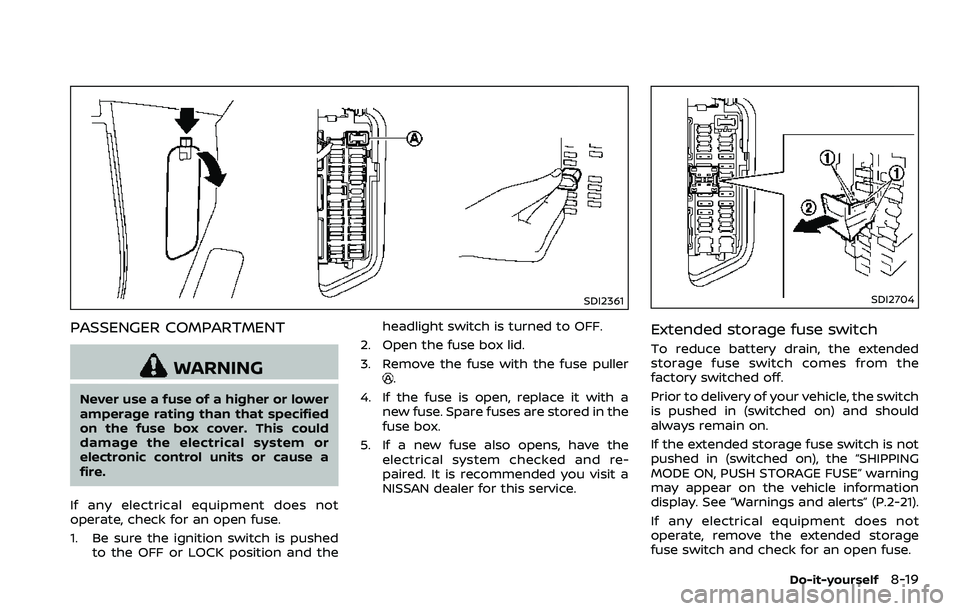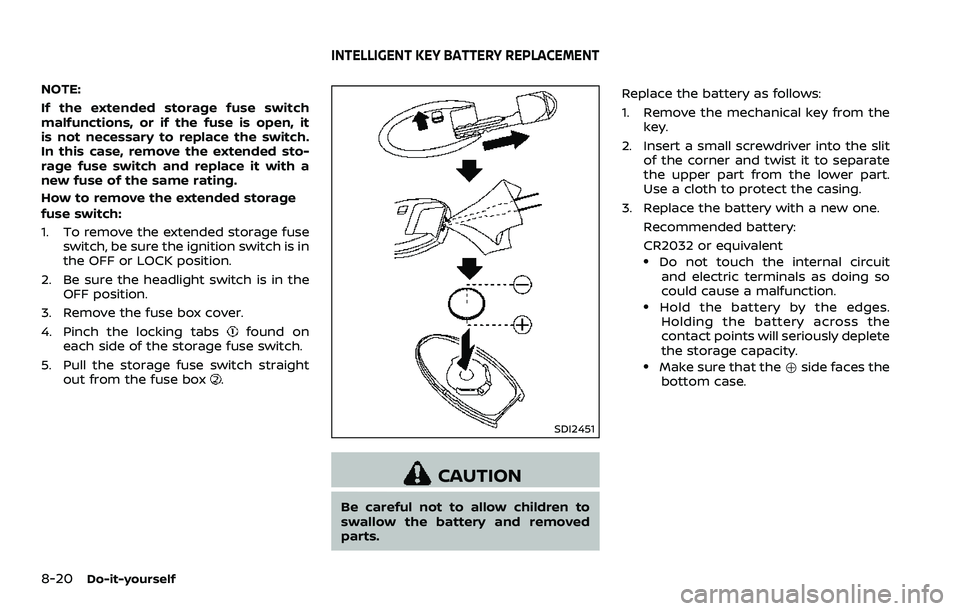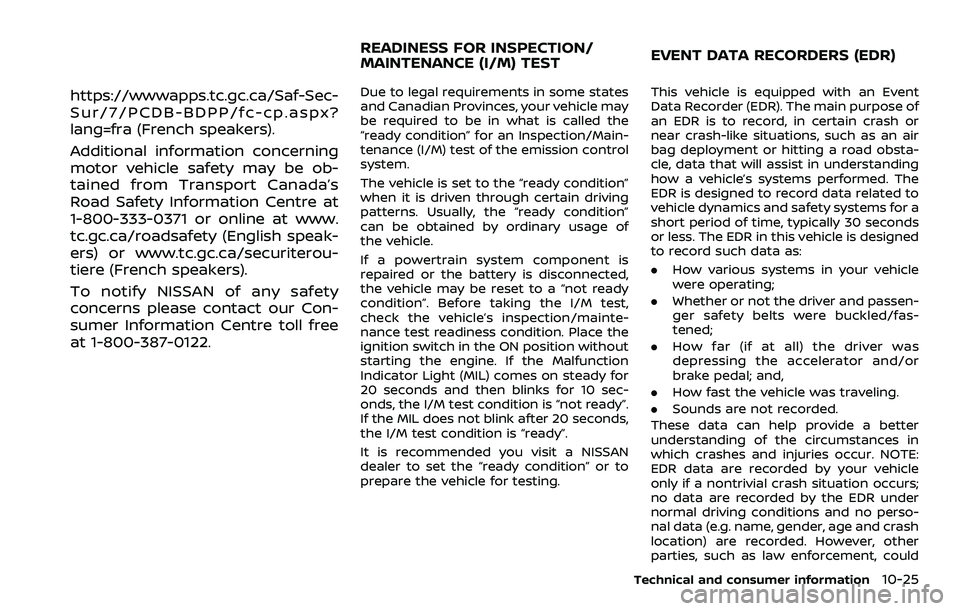2018 NISSAN 370Z COUPE battery
[x] Cancel search: batteryPage 375 of 453

SDI1480E
2. Add distilled water up to the UPPERLEVELline.
If the side of the battery is not clear,
check the distilled water level by
looking directly above the cell; the
condition
indicates OK and the
conditionsneeds more to be added.
3. Tighten cell plugs
.
Vehicles operated in high temperatures
or under severe conditions require fre-
quent checks of the battery fluid level.
JUMP STARTING
If jump starting is necessary, see “Jump
starting” (P.6-15). If the engine does not
start by jump starting, the battery may
have to be replaced. It is recommended
you visit a NISSAN dealer for this service.CAUTION
. Do not ground accessories di-
rectly to the battery terminal.
Doing so will bypass the variable
voltage control system and the
vehicle battery may not charge
completely.
. Use electrical accessories with
the engine running to avoid dis-
charging the vehicle battery.
The variable voltage control system mea-
sures the amount of electrical discharge
from the battery and controls voltage
generated by the generator.
Do-it-yourself8-13
VARIABLE VOLTAGE CONTROL SYSTEM
Page 381 of 453

SDI2361
PASSENGER COMPARTMENT
WARNING
Never use a fuse of a higher or lower
amperage rating than that specified
on the fuse box cover. This could
damage the electrical system or
electronic control units or cause a
fire.
If any electrical equipment does not
operate, check for an open fuse.
1. Be sure the ignition switch is pushed to the OFF or LOCK position and the headlight switch is turned to OFF.
2. Open the fuse box lid.
3. Remove the fuse with the fuse puller
.
4. If the fuse is open, replace it with a new fuse. Spare fuses are stored in the
fuse box.
5. If a new fuse also opens, have the electrical system checked and re-
paired. It is recommended you visit a
NISSAN dealer for this service.
SDI2704
Extended storage fuse switch
To reduce battery drain, the extended
storage fuse switch comes from the
factory switched off.
Prior to delivery of your vehicle, the switch
is pushed in (switched on) and should
always remain on.
If the extended storage fuse switch is not
pushed in (switched on), the “SHIPPING
MODE ON, PUSH STORAGE FUSE” warning
may appear on the vehicle information
display. See “Warnings and alerts” (P.2-21).
If any electrical equipment does not
operate, remove the extended storage
fuse switch and check for an open fuse.
Do-it-yourself8-19
Page 382 of 453

8-20Do-it-yourself
NOTE:
If the extended storage fuse switch
malfunctions, or if the fuse is open, it
is not necessary to replace the switch.
In this case, remove the extended sto-
rage fuse switch and replace it with a
new fuse of the same rating.
How to remove the extended storage
fuse switch:
1. To remove the extended storage fuseswitch, be sure the ignition switch is in
the OFF or LOCK position.
2. Be sure the headlight switch is in the OFF position.
3. Remove the fuse box cover.
4. Pinch the locking tabs
found on
each side of the storage fuse switch.
5. Pull the storage fuse switch straight out from the fuse box
.
SDI2451
CAUTION
Be careful not to allow children to
swallow the battery and removed
parts. Replace the battery as follows:
1. Remove the mechanical key from the
key.
2. Insert a small screwdriver into the slit of the corner and twist it to separate
the upper part from the lower part.
Use a cloth to protect the casing.
3. Replace the battery with a new one.
Recommended battery:
CR2032 or equivalent
.Do not touch the internal circuitand electric terminals as doing so
could cause a malfunction.
.Hold the battery by the edges.Holding the battery across the
contact points will seriously deplete
the storage capacity.
.Make sure that the +side faces the
bottom case.
INTELLIGENT KEY BATTERY REPLACEMENT
Page 404 of 453

9-4Maintenance and schedules
properly and smoothly, and are installed
securely. Check the belt webbing for cuts,
fraying, wear or damage.
Steering wheel:Check for changes in the
steering conditions, such as excessive
free play, hard steering or strange noises.
Warning lights and chimes: Make sure
that all warning lights and chimes are
operating properly.
Windshield defroster: Check that the air
comes out of the defroster outlets prop-
erly and in sufficient quantity when oper-
ating the heater or air conditioner.
Windshield wiper and washer*: Check
that the wipers and washer operate
properly and that the wipers do not
streak.
Under the hood and vehicle
The maintenance items listed here should
be checked periodically (for example,
each time you check the engine oil or
refuel).
Battery*: Check the fluid level in each cell.
It should be between the MAX and MIN
lines. Vehicles operated in high tempera-
tures or under severe condition require
frequent checks of the battery fluid level. NOTE:
Care should be taken to avoid situations
that can lead to potential battery dis-
charge and potential no-start condi-
tions such as:
1.
Installation or extended use of elec-
tronic accessories that consume
battery power when the engine is
not running (Phone chargers, GPS,
DVD players, etc.)
2. Vehicle is not driven regularly and/
or only driven short distances.
In these cases, the battery may need to
be charged to maintain battery health.
Brake and clutch fluid levels*: Make sure
that the brake and clutch fluid levels are
between the MAX and MIN lines on the
reservoir.
Engine coolant level*: Check the coolant
level when the engine is cold.
Engine drive belts*: Make sure that no
belt is frayed, worn, cracked or oily.
Engine oil level*: Check the level after
parking the vehicle on a level spot and
turning off the engine. Wait more than 15
minutes for the oil to drain back into the
oil pan.
Exhaust system: Make sure there are no
loose supports, cracks or holes. If the
sound of the exhaust seems unusual or
there is a smell of exhaust fumes, im- mediately have the exhaust system in-
spected. It is recommended you visit a
NISSAN dealer for this service. (See “Pre-
cautions when starting and driving” (P.5-
2) for exhaust gas (carbon monoxide).)
Fluid leaks:
Check under the vehicle for
fuel, oil, water or other fluid leaks after the
vehicle has been parked for a while. Water
dripping from the air conditioner after use
is normal. If you should notice any leaks
or if gasoline fumes are evident, check for
the cause and have it corrected immedi-
ately.
Power steering fluid level* and lines:
Check the level when the fluid is cold, with
the engine off. Check the lines for proper
attachment, leaks, cracks, etc.
Radiator and hoses: Check the front of
the radiator and clean off any dirt, insects,
leaves, etc., that may have accumulated.
Make sure the hoses have no cracks,
deformation, rot or loose connections.
Underbody: The underbody is frequently
exposed to corrosive substances such as
those used on icy roads or to control
dust. It is very important to remove these
substances, otherwise rust will form on
the floor pan, frame, fuel lines and around
the exhaust system. At the end of winter,
the underbody should be thoroughly
flushed with plain water, being careful to
clean those areas where mud and dirt
Page 411 of 453

CHASSIS AND BODY MAINTENANCE
Abbreviations: I = Inspect and correct or replace as necessary, R = Replace
MAINTENANCE OPERATION
Perform at of miles, kilo-
meters or months, whichever
comes first.Miles × 1,000
(km × 1,000) Months MAINTENANCE INTERVAL
5
(8) 6 10
(16) 12 15
(24) 18 20
(32) 24 25
(40) 30 30
(48) 36 35
(56) 42 40
(64) 48 45
(72) 54 50
(80) 60 55
(88) 66 60
(96) 72
Brake lines and cables II II I I
Brake pads and rotors$ II I I I I
Brake fluid$ RR R
Automatic transmission fluid See NOTE (1)
Manual transmission gear oil
and differential gear oil See NOTE (2)
II II I I
Steering gear and linkage,
axle and suspension parts$ II I
Tire rotation See NOTE (3)
Exhaust system$ II I
In-cabin microfilter RR R R
Intelligent Key battery RR R R
Maintenance and schedules9-11
Page 412 of 453

9-12Maintenance and schedules
MAINTENANCE OPERATION
Perform at of miles, kilo-
meters or months, which-
ever comes first.Miles × 1,000
(km × 1,000) Months MAINTENANCE INTERVAL
65
(104) 78 70
(112) 84 75
(120) 90 80
(128) 96 85
(136) 102 90
(144) 108 95
(152) 114 100
(160) 120 105
(168) 126 110
(176) 132 115
(184) 138 120
(192) 144
Brake lines & cables II II I I
Brake pads & rotors$ II II I I
Brake fluid$ RR R
Automatic transmission fluid See NOTE (1)
Manual transmission gear oil
& differential gear oil See NOTE (2)
II II I I
Steering gear & linkage, axle
& suspension parts$ II I
Tire rotation See NOTE (3)
Exhaust system$ III
In-cabin microfilter RRR R
Intelligent Key battery RRR R
NOTE:
Maintenance items with “$” should be
performed more frequently according
to “Maintenance under severe driving
conditions” (P.9-13).
(1) Periodic maintenance is not required.
(2) If using a car-top carrier, or driving
on rough or muddy roads, change (not
just inspect) oil at every 20,000 miles
(32,000 km) or 24 months. (3) Refer to “Tire rotation” under “Gen-
eral maintenance” (P.9-2).
Page 443 of 453

https://wwwapps.tc.gc.ca/Saf-Sec-
Sur/7/PCDB-BDPP/fc-cp.aspx?
lang=fra (French speakers).
Additional information concerning
motor vehicle safety may be ob-
tained from Transport Canada’s
Road Safety Information Centre at
1-800-333-0371 or online at www.
tc.gc.ca/roadsafety (English speak-
ers) or www.tc.gc.ca/securiterou-
tiere (French speakers).
To notify NISSAN of any safety
concerns please contact our Con-
sumer Information Centre toll free
at 1-800-387-0122.Due to legal requirements in some states
and Canadian Provinces, your vehicle may
be required to be in what is called the
“ready condition” for an Inspection/Main-
tenance (I/M) test of the emission control
system.
The vehicle is set to the “ready condition”
when it is driven through certain driving
patterns. Usually, the “ready condition”
can be obtained by ordinary usage of
the vehicle.
If a powertrain system component is
repaired or the battery is disconnected,
the vehicle may be reset to a “not ready
condition”. Before taking the I/M test,
check the vehicle’s inspection/mainte-
nance test readiness condition. Place the
ignition switch in the ON position without
starting the engine. If the Malfunction
Indicator Light (MIL) comes on steady for
20 seconds and then blinks for 10 sec-
onds, the I/M test condition is “not ready”.
If the MIL does not blink after 20 seconds,
the I/M test condition is “ready”.
It is recommended you visit a NISSAN
dealer to set the “ready condition” or to
prepare the vehicle for testing.This vehicle is equipped with an Event
Data Recorder (EDR). The main purpose of
an EDR is to record, in certain crash or
near crash-like situations, such as an air
bag deployment or hitting a road obsta-
cle, data that will assist in understanding
how a vehicle’s systems performed. The
EDR is designed to record data related to
vehicle dynamics and safety systems for a
short period of time, typically 30 seconds
or less. The EDR in this vehicle is designed
to record such data as:
.
How various systems in your vehicle
were operating;
. Whether or not the driver and passen-
ger safety belts were buckled/fas-
tened;
. How far (if at all) the driver was
depressing the accelerator and/or
brake pedal; and,
. How fast the vehicle was traveling.
. Sounds are not recorded.
These data can help provide a better
understanding of the circumstances in
which crashes and injuries occur. NOTE:
EDR data are recorded by your vehicle
only if a nontrivial crash situation occurs;
no data are recorded by the EDR under
normal driving conditions and no perso-
nal data (e.g. name, gender, age and crash
location) are recorded. However, other
parties, such as law enforcement, could
Technical and consumer information10-25
READINESS FOR INSPECTION/
MAINTENANCE (I/M) TEST EVENT DATA RECORDERS (EDR)
Page 445 of 453

11 Index
A
ABS (Anti-lock Braking System) ......................... 5-28
Active noise cancellation......................................... 5-35
Active sound enhancement.................................. 5-35
Advanced air bag system ........................................ 1-36
Air bag systemAdvanced air bag system ................................ 1-36
Front passenger air bag and
status light................................................................... 1-38
Front-seat mounted side-impact
supplemental air bag system........................ 1-41
Roof-mounted curtain side-impact
supplemental air bag system........................ 1-41
Air bag warning labels ............................................... 1-44
Air bag warning light...................................... 1-44, 2-14
Air cleaner housing filter .......................................... 8-15
Air conditioner Air conditioner operation................................ 4-25
Air conditioner service....................................... 4-30
Air conditioner specification label........... 10-14
Air conditioning system refrigerant and
lubricant recommendations ............ 4-30, 10-8
In-cabin microfilter ............................................... 4-30
Air deflectors ................................................................... 10-18
Alarm, How to stop alarm (see vehicle
security system)............................................................. 2-30
Alcohol, drugs and driving ........................................ 5-7
Antenna........................................................................\
......... 4-74
Anti-lock Braking System (ABS) ......................... 5-28
Anti-lock braking system (ABS)
warning light ....................................................................... 2-11
Appearance care Exterior appearance care .................................. 7-2
Interior appearance care.................................... 7-5
Audible reminders.......................................................... 2-18 Audio operation precautions .............................. 4-30
Audio system ................................................................... 4-30
FM-AM radio with Compact Disc
(CD) player ................................................................... 4-43
FM-AM-SAT radio with Compact Disc
(CD) player ................................................................... 4-52
Steering wheel audio controls.................... 4-73
Autolight system............................................................ 2-35
Automatic Air conditioner (Type A).................................... 4-26
Air conditioner (Type B).................................... 4-28
Automatic adjusting function
(front windows) ....................................................... 2-49
Automatic Transmission Fluid (ATF) ......... 8-8
Door locks....................................................................... 3-6
Driving with automatic transmission..... 5-12
Auxiliary input jacks.................................................... 4-70
Avoiding collision and rollover............................... 5-6
B
Battery........................................................................\
.............. 8-11 Battery saver system.......................................... 2-36
Intelligent Key........................................................... 8-20
Variable voltage control system ................ 8-13
Before starting the engine....................................... 5-11
Belts (See drive belts).................................................. 8-14
Bluetooth® hands-free phone system
(models with navigation system) ..................... 4-76
Bluetooth® hands-free phone system
(models without navigation system) ............ 4-86
Bluetooth® streaming audio................................. 4-63
Booster seats...................................................................\
.. 1-26
Brake Anti-lock Braking System (ABS) ................. 5-28
Brake and clutch fluid .......................................... 8-9 Brake fluid ...................................................................... 8-9
Brake system ............................................................ 5-27
Parking brake operation................................... 5-21
Warning light............................................................... 2-11
Break-in schedule ......................................................... 5-24
Brightness control .......................................................... 4-8 Display ON/OFF button ....................................... 4-8
Instrument panel ................................................... 2-37
Bulb replacement .......................................................... 8-22
C
Cabin air filter .................................................................. 4-30
Capacities and
recommended fluids/lubricants........................ 10-2
Car phone or CB radio .............................................. 4-75
Cargo cover ....................................................................... 2-45
Catalytic converter, Three way catalyst ........ 5-3
CD/DVD/USB memory care
and cleaning...................................................................... 4-72
Center multi-function control panel
(models with navigation system) ....................... 4-4
Chassis and body maintenance.......................... 9-11
Child restraints .................................................................. 1-19 Booster seats............................................................. 1-26
Precautions on child restraints.................... 1-19
Top tether strap ...................................................... 1-20
Child safety........................................................................\
... 1-16
Chimes Audible reminders.................................................. 2-18
Seat belt warning light and chime........... 2-14
Circuit breaker, Fusible link ................................... 8-18
Cleaning exterior and interior ...................... 7-2, 7-5
Clock ........................................................................\
...... 2-9, 2-27
Clutch fluid........................................................................\
.... 8-9
Cockpit ........................................................................\
.............. 2-3